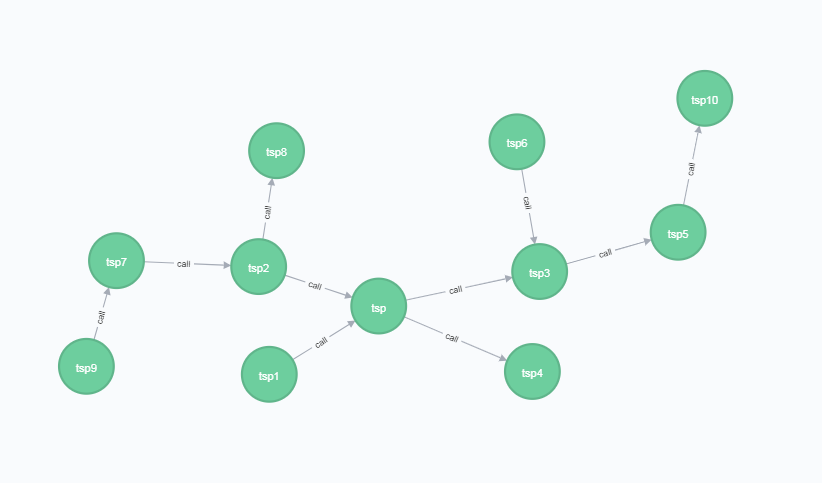参考文档
官方文档
- http://spring.io/projects/spring-data-neo4j#learn
- https://docs.spring.io/spring-data/neo4j/docs/5.1.2.RELEASE/reference/html/
- https://neo4j.com/docs/
- https://neo4j.com/docs/developer-manual/current/
第三方使用文档
- https://blog.csdn.net/appleyk/article/category/7408344 系列文档
- https://blog.csdn.net/u013946356/article/details/81739079
中文手册(比较滞后)
- https://www.w3cschool.cn/neo4j/
安装 maven 包
<dependency>
<groupId>org.neo4j</groupId>
<artifactId>neo4j-ogm-http-driver</artifactId>
<version>3.1.4</version>
</dependency>
<dependency>
<groupId>org.springframework.boot</groupId>
<artifactId>spring-boot-starter-data-neo4j</artifactId>
<version>2.1.0.RELEASE</version>
</dependency>
添加 neo4j 配置
application.yml
spring: data: neo4j: username: neo4j password: 1234 uri: http://172.16.235.175:7474
添加配置类
@Configuration @EnableNeo4jRepositories(basePackages = "com.example.demo.repository") @EnableTransactionManagement public class Neo4jConfig { @Value("${spring.data.neo4j.uri}") private String databaseUrl; @Value("${spring.data.neo4j.username}") private String userName; @Value("${spring.data.neo4j.password}") private String password; @Bean public SessionFactory sessionFactory() { org.neo4j.ogm.config.Configuration configuration = new org.neo4j.ogm.config.Configuration.Builder() .uri(databaseUrl) .credentials(userName, password) .build(); return new SessionFactory(configuration, "com.example.demo.entity"); } @Bean public Neo4jTransactionManager transactionManager() { return new Neo4jTransactionManager(sessionFactory()); } }
添加 Neo4j 节点类
@NodeEntity public class SGNode { private Long count; private Long error; private Double max; private Double min; /** * Neo4j会分配的ID(节点唯一标识 当前类中有效) */ @Id @GeneratedValue private Long id; private String name; public Long getId() { return id; } public void setId(Long id) { this.id = id; } public String getName() { return name; } public void setName(String name) { this.name = name; } @Relationship(type = "call") private List<CallRelation> calls; public SGNode() { count = 0L; error = 0L; max = 0.0; min = 0.0; calls = new ArrayList<>(); } public SGNode(String name) { this(); this.name = name; } public Long getCount() { return count; } public void setCount(Long count) { this.count = count; } public Long getError() { return error; } public void setError(Long error) { this.error = error; } public Double getMax() { return max; } public void setMax(Double max) { this.max = max; } public Double getMin() { return min; } public void setMin(Double min) { this.min = min; } public List<CallRelation> getCalls() { return calls; } public void setCalls(List<CallRelation> calls) { this.calls = calls; } public void addCalls(SGNode node, Long count) { CallRelation relation = new CallRelation(this, node, count); this.calls.add(relation); } }
添加 Neo4j 关系类
@RelationshipEntity(type = "call") public class CallRelation { public CallRelation() { this.name = "call"; } public CallRelation(SGNode start, SGNode end, Long count) { this(); this.startNode = start; this.endNode = end; this.count = count; } /** * Neo4j会分配的ID(节点唯一标识 当前类中有效) */ @Id @GeneratedValue private Long id; private String name; public Long getId() { return id; } public void setId(Long id) { this.id = id; } public String getName() { return name; } public void setName(String name) { this.name = name; } /** * 定义关系的起始节点 == StartNode */ @StartNode private SGNode startNode; /** * 定义关系的终止节点 == EndNode */ @EndNode private SGNode endNode; /** * 定义关系的属性 */ @Property(name = "count") private Long count; public SGNode getStartNode() { return startNode; } public void setStartNode(SGNode startNode) { this.startNode = startNode; } public SGNode getEndNode() { return endNode; } public void setEndNode(SGNode endNode) { this.endNode = endNode; } public Long getCount() { return count; } public void setCount(Long count) { this.count = count; } }
添加 Reponsitory
@Repository public interface SGNodeReponsitory extends Neo4jRepository<SGNode, Long> {
// 此处用法可见 https://docs.spring.io/spring-data/neo4j/docs/5.1.2.RELEASE/reference/html/#_query_methods SGNode findByName(@Param("name") String name); }
使用 Demo
@RestController @RequestMapping("/sg") public class SGNodeController { @Autowired SGNodeReponsitory sgNodeReponsitory; @DeleteMapping("/delete") public String delete() { sgNodeReponsitory.deleteAll(); return "OK"; } @GetMapping("/add") public String add() { addNodes(); return "OK"; } @GetMapping("/get") public String relation() { SGNode node = sgNodeReponsitory.findByName("tsp"); List<Long> ids = new ArrayList<>(); ids.add(node.getId()); Iterable<SGNode> result = sgNodeReponsitory.findAllById(ids, 1); return "OK"; } private void addNodes() { sgNodeReponsitory.deleteAll(); List<SGNode> list = new ArrayList<>(); SGNode node = new SGNode("tsp"); list.add(node); for (Integer i = 1; i <= 10; i++) { node = new SGNode("tsp" + i); node.setCount(new Random().nextLong()); node.setError(new Random().nextLong()); node.setMax(new Random().nextDouble()); node.setMin(new Random().nextDouble()); list.add(node); } sgNodeReponsitory.saveAll(list); SGNode start = sgNodeReponsitory.findByName("tsp1"); SGNode end = sgNodeReponsitory.findByName("tsp"); start.addCalls(end, new Random().nextLong()); sgNodeReponsitory.save(start); start = sgNodeReponsitory.findByName("tsp2"); end = sgNodeReponsitory.findByName("tsp"); start.addCalls(end, new Random().nextLong()); sgNodeReponsitory.save(start); start = sgNodeReponsitory.findByName("tsp9"); end = sgNodeReponsitory.findByName("tsp7"); start.addCalls(end, new Random().nextLong()); sgNodeReponsitory.save(start); start = sgNodeReponsitory.findByName("tsp7"); end = sgNodeReponsitory.findByName("tsp2"); start.addCalls(end, new Random().nextLong()); sgNodeReponsitory.save(start); start = sgNodeReponsitory.findByName("tsp2"); end = sgNodeReponsitory.findByName("tsp8"); start.addCalls(end, new Random().nextLong()); sgNodeReponsitory.save(start); start = sgNodeReponsitory.findByName("tsp"); end = sgNodeReponsitory.findByName("tsp3"); start.addCalls(end, new Random().nextLong()); sgNodeReponsitory.save(start); start = sgNodeReponsitory.findByName("tsp"); end = sgNodeReponsitory.findByName("tsp4"); start.addCalls(end, new Random().nextLong()); sgNodeReponsitory.save(start); start = sgNodeReponsitory.findByName("tsp6"); end = sgNodeReponsitory.findByName("tsp3"); start.addCalls(end, new Random().nextLong()); sgNodeReponsitory.save(start); start = sgNodeReponsitory.findByName("tsp3"); end = sgNodeReponsitory.findByName("tsp5"); start.addCalls(end, new Random().nextLong()); sgNodeReponsitory.save(start); start = sgNodeReponsitory.findByName("tsp5"); end = sgNodeReponsitory.findByName("tsp10"); start.addCalls(end, new Random().nextLong()); sgNodeReponsitory.save(start); } }
执行 Add 操作之后
